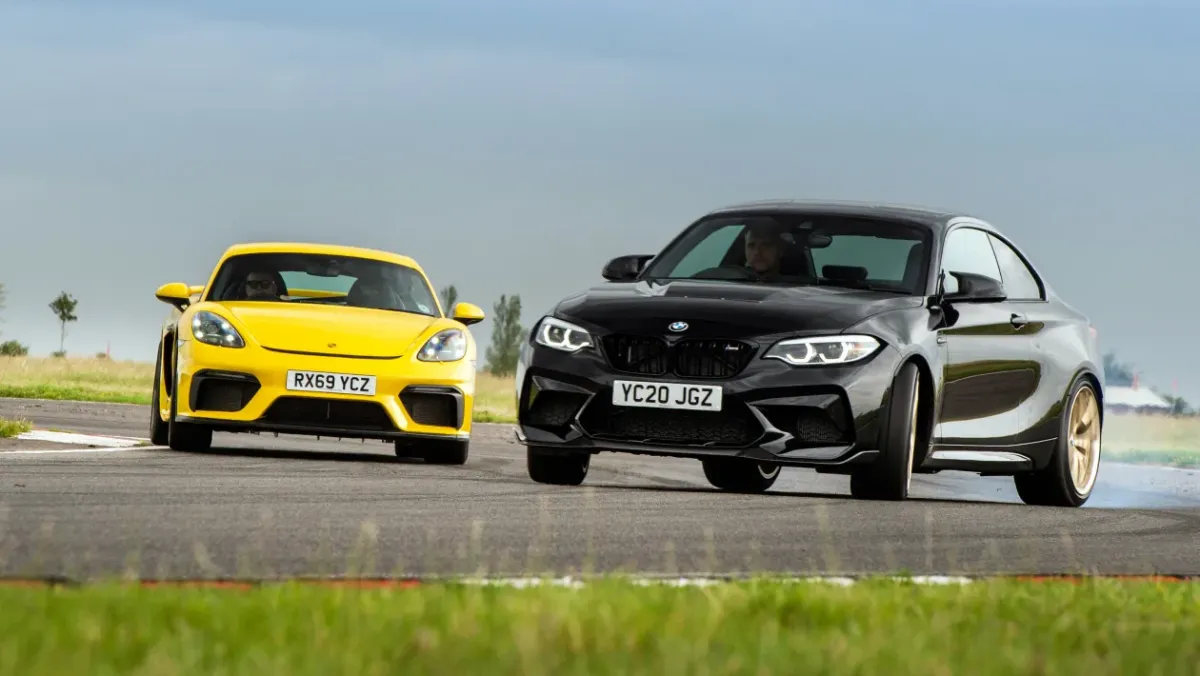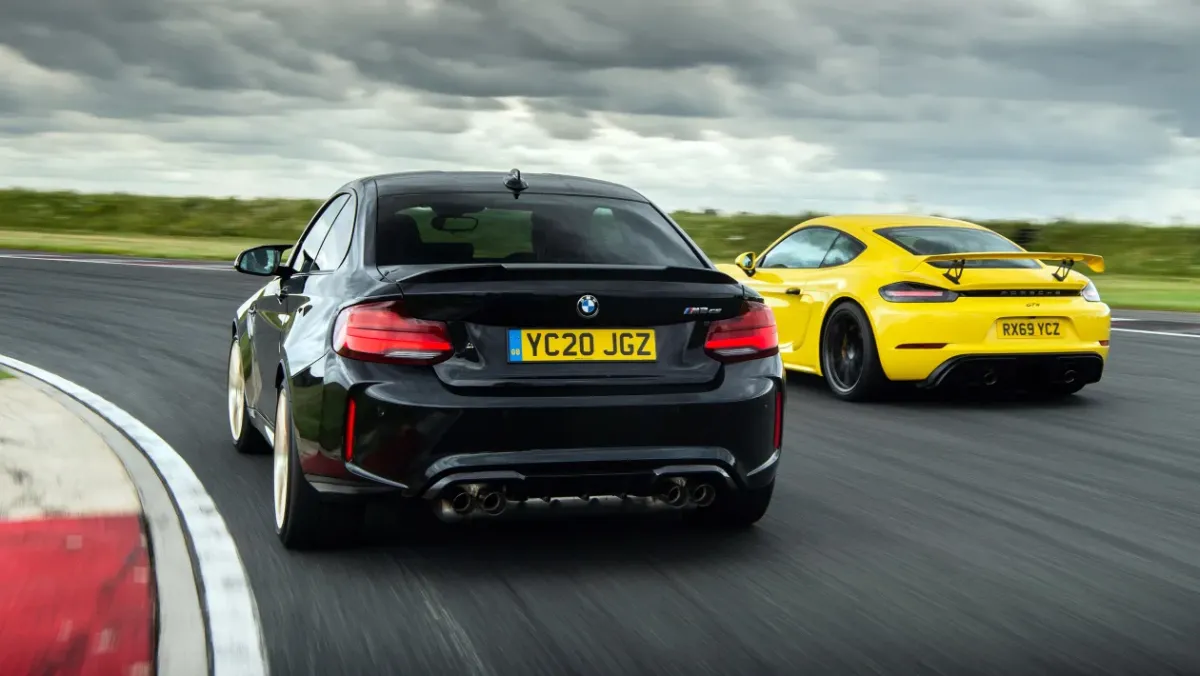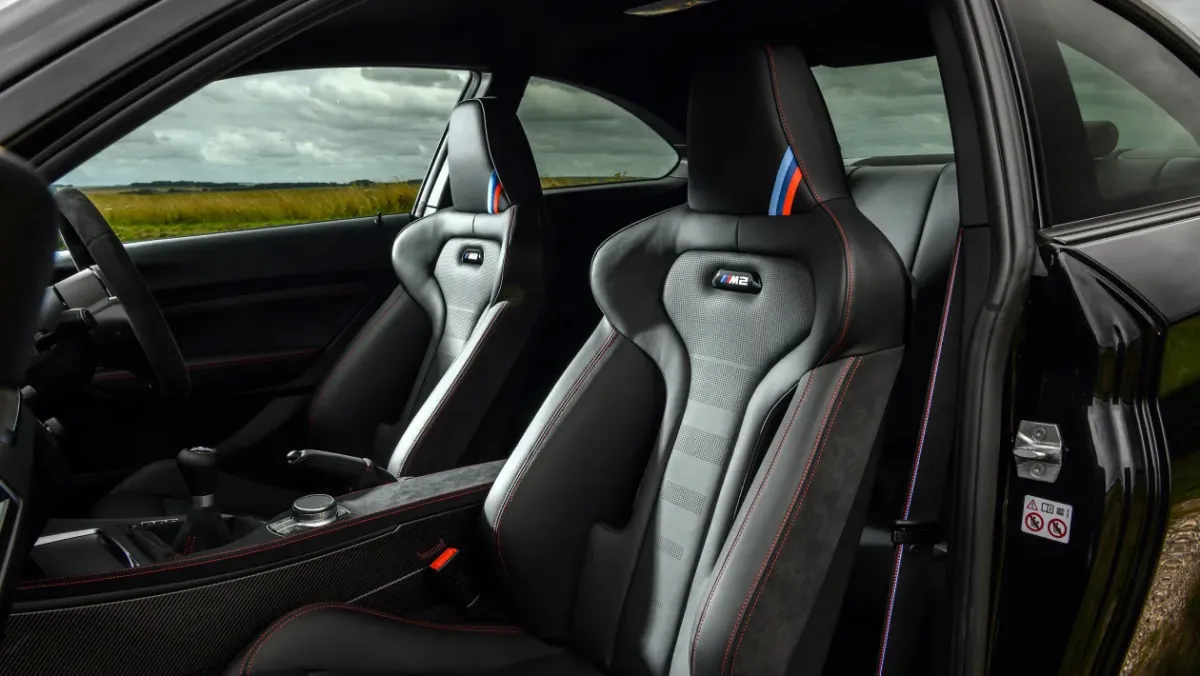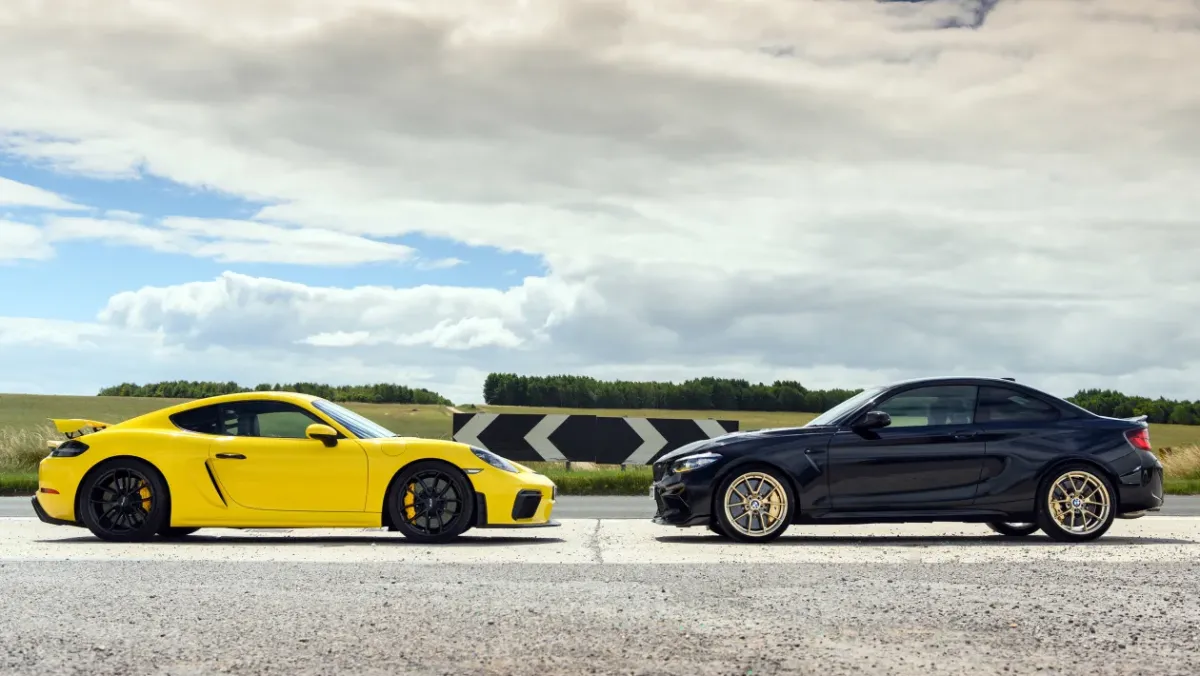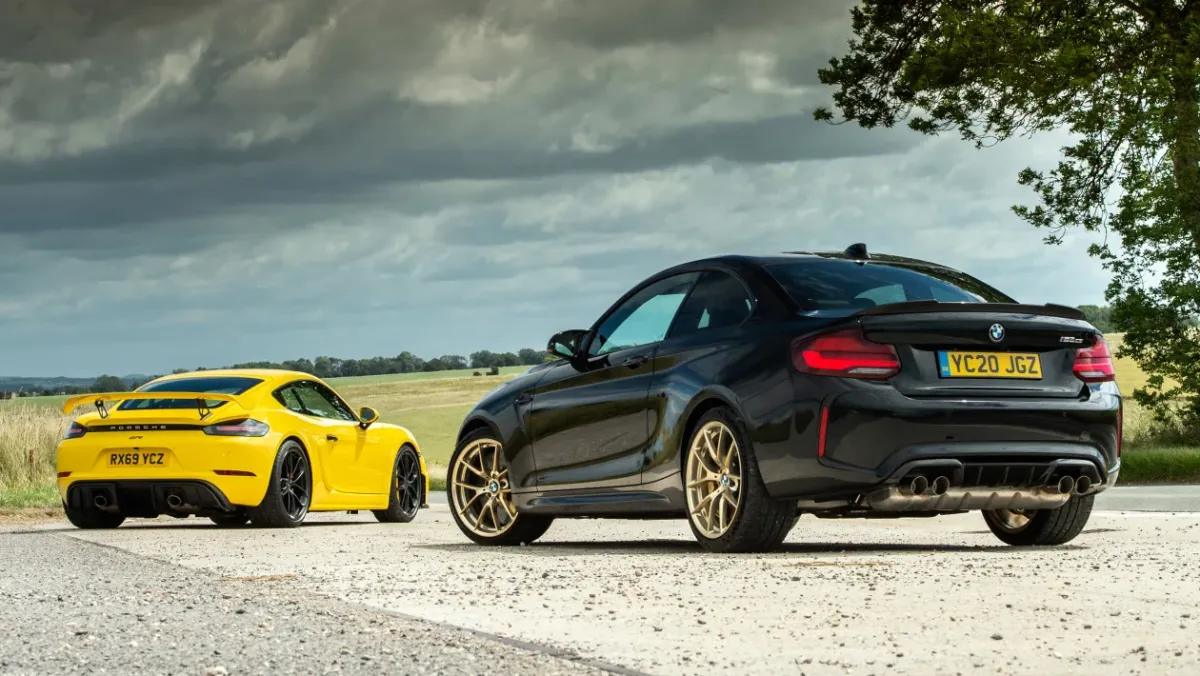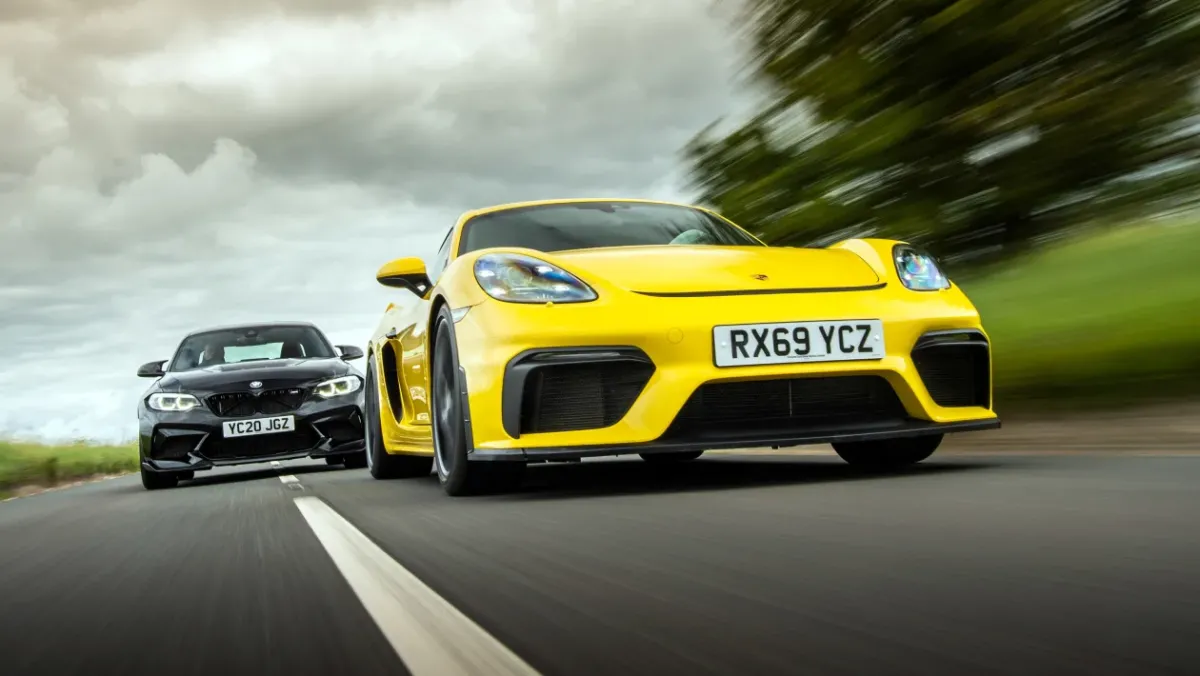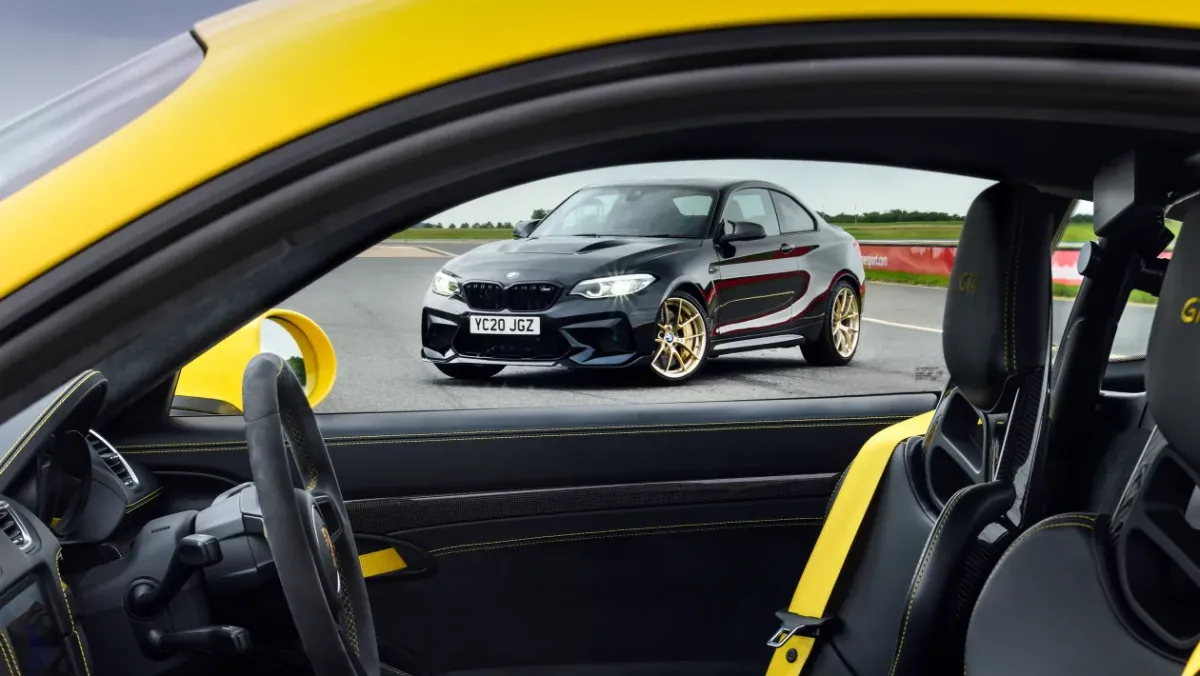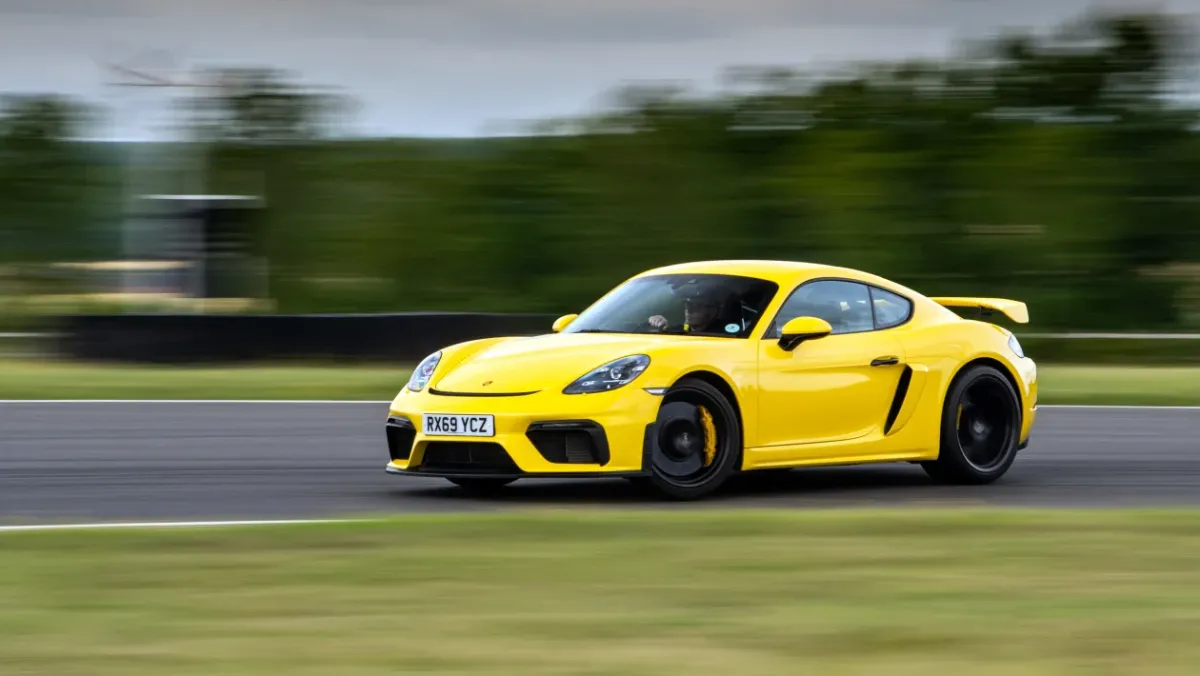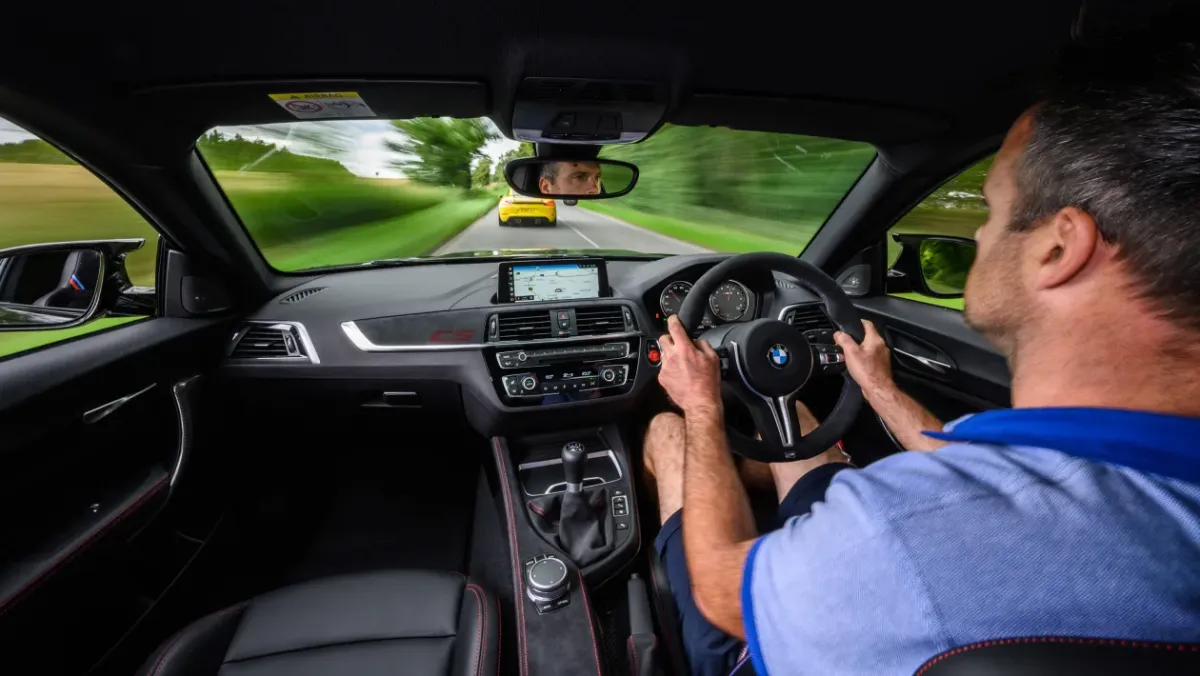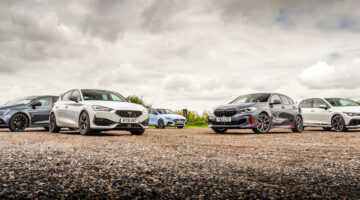The M2 CS may be an M-car at the top of its game, but at its price and performance point it faces one very serious rival: our 2019 Car of the Year, the Porsche 718 Cayman GT4. Can it beat it?
We like the M2 CS. We love it, in fact. Though no longer on sale, there’s no getting away from the fact that ‘our’ $91,043-as-tested black and gold example was essentially a hotted-up 2-series sparring in some fiercely contested and grown-up waters. This is the story then, about a battle between a rather upright, feisty compact 2+2 coupe and Porsche Motorsport’s junior warrior, a car that patrols said waters like a shark with territorial issues.
They were born less than 250 kilometers apart in neighbouring German states, and both are powered by six-cylinder internal combustion engines of real substance. A common bond of scorched Michelins Cup 2s, long, hot, bug-splattered days at the Nordschleife and irresistible double-take visuals links them amongst dreary, increasingly autonomous cars, and yet they couldn’t be more different if they tried. Right now, the frisson of antagonistic tension between the bulging metalwork, bespoilered and bewinged rumps and agitated big-volume idles of them both is palpable. Thanks to the pandemic this was the first big test we’d conducted in months, but I also think it was one of the most interesting we’d seen for quite some time.
Hailing confidently from Weissach is our reigning, the 718 Cayman GT4. Entering the arena to a champion’s fanfare of trumpets, it exudes inner confidence born from both its own successes and its illustrious lineage, and takes the moral high ground in enthusiast circles from fielding an all-new naturally aspirated engine. I won’t be coy. I love it. After the lofty perched driving position of the M2 it’s as though the cheeks of your posterior are almost scraping along the road’s surface in the GT4, the snow-plough front bib even lower, the massive wing on stilts visible in the rear-view mirror. Ka-ka-ka-BOOM! fires up the 414bhp flat-six, and just for the briefest moment the world’s issues obscure in a warming haze of burnt hydrocarbons. I have spent a lot of time in the M2 CS over the past 48 hours. In fact, I’d go as far as to say I haven’t wanted to stop driving it, but the GT4 can turn your head in mere moments…
I must admit, I don’t recall the new 4-litre engine being quite this boisterous on start-up. It’s rapidly becoming apparent from the earbashing I’m getting that the Porsche’s sports exhaust has its valves jammed open, a legacy of its inactivity during lockdown. Now, such a minor infringement, particularly in these unheard of times, would not normally warrant a mention in print. However, it inadvertently answers a question we’ve been pondering at evo for a while. Namely, what would the new motor really sound like with its rather overbearing rev and load-dependent shackles removed? How much does the fitment of a gasoline particulate filter really affect its voice? Or not?
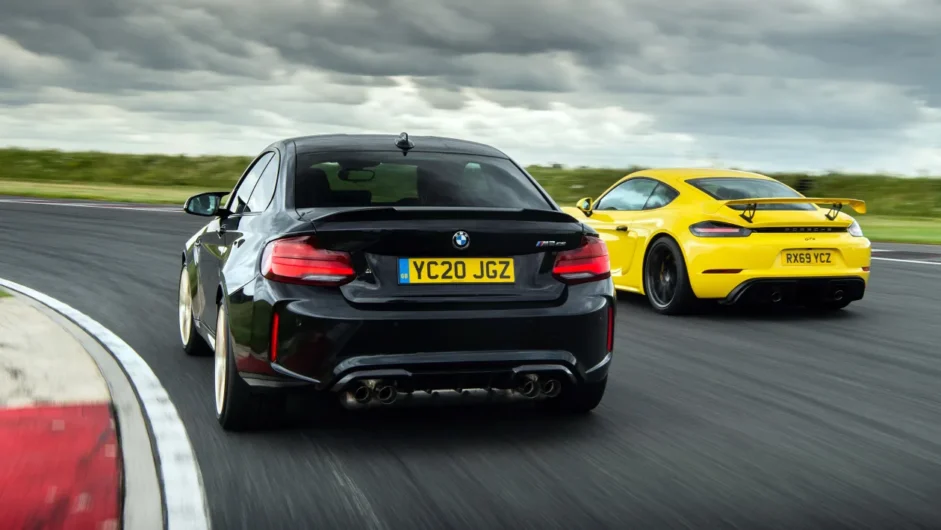
The answer is confirmation of a hunch I’ve had from the start. It’s a beast. Less sonically sophisticated than the MA1 from the GT3 models, and certainly without the exotic zing at the top end, but very much son-of-Mezger (rest in peace, Hans) in the thick, multi-layered bellow that rises to a scream. It’s almost a bit too much when you’re just pootling around, the deep low-rev frequencies playing havoc with your eardrums, but then I’m forced to give myself a slap around the chops for such a sacrilegious thought. This is a GT4. It should be loud and proud!
The early rounds are a triumph for the Porsche, and for good reason. When it comes to the quality of controls that you, the driver, interact with, few consistently reach the standard that Porsche does. It’s one of the fundamental reasons why its cars have triumphed more times than we care to mention over the history of this publication. I don’t need to drive to our deliberately unnamed favourite roads in Yorkshire or the Scottish Borders to work that out. It’s obvious in the first 500 yards and at no more than 50kph. The Kerdunkt-kerkikt as the lever goes through the gate, as though your fingers are lashed directly to the synchro cones and cogs, there being no obvious limit to the speed with which a gearchange can be executed – a far cry from the BMW with its characteristic halfway ‘notch’. Basic things, such as the steering wheel. I know, here we go again. But honestly, in the Porsche the rim is a much more manageable size, and it narrows at the cutouts where just beneath the soft, grippy Alcantara is a solid surface, allowing nuances from the front wheels to transfer through the rack to your fingertips. And the way the wheel turns exactly at the rate and with the resistance you’d expect, immediately away from the straight-ahead. Or the brakes; both cars here have optional carbon-ceramics, but they’re so much more measured in their response in the Porsche, the firmer initial bite inspiring more confidence and the added resistance giving a reliable perch for heel-and-toe downchanges. Even the clutch is perfectly in tune in terms of weighting and the arc of its travel; it’s holistic car development in action. The GT4 is a car you can drive almost instantly as though you’ve owned it for years.
This GT4 feels the strongest of the three 718 GT4s I’ve been lucky enough to drive so far. The first, a Carrara White LHD pre-production car taken away from the end of the international launch event at Knockhill circuit and driven into mountain country, felt lively but not especially so. The second, a Gentian Blue example trucked straight from Stuttgart to eCoty last year in southern Spain, didn’t quite have the top-end fizz we were expecting, and as a result led to criticism from some judges that the new GT4 was being neutered slightly for a possible GT4 RS further down the line. But this Racing Yellow car positively sprints for its 8000rpm red line, which – I know, what I’m about to say is like a game of Porsche-evo bingo – would be even better if you could access it more of the time. But you can’t, because the gearing – go on, tick that box – is so infuriatingly long. While this thorny issue of gearing is almost certainly due to emissions regulations, it probably makes some sense on a long, fast European circuit such as Spa, but it certainly doesn’t on a British B-road, where the overriding feeling is of hanging on, watching the revs climb and then catching some rather naughty numbers on the speedometer. Rare is the occasion when anything other than second gear, or third at the most, is required when you’re having fun.
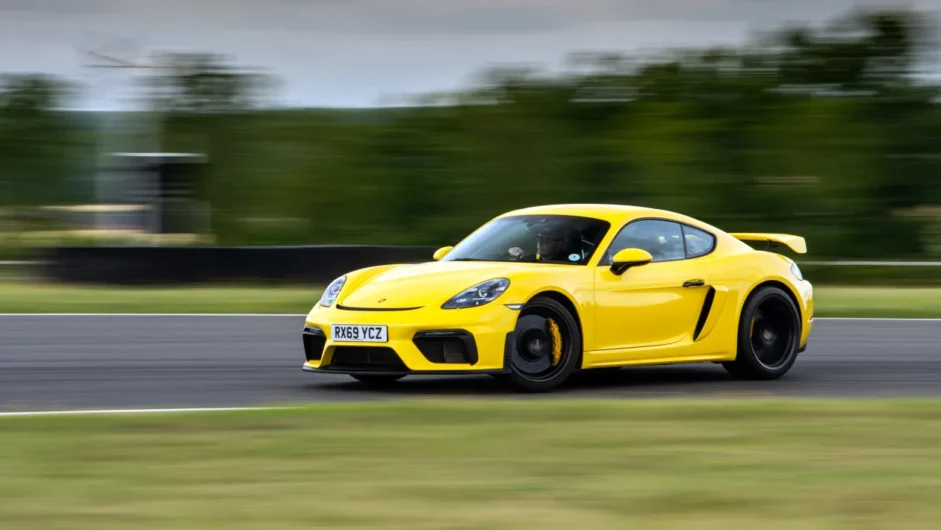
Is this the chink in the GT4’s armour that the M2 requires? Having had a blast in the Cayman, getting back into the CS you’re presented with a much more conventional environment. Even so, there’s something about the relatively snug interior, the good visibility out and the reassuring practicality of the rear pews that makes for a potent mix with the car’s driving abilities. It’s a do-it-all sort of performance car, one that could adapt to most lifestyles with only a little bit of commitment. You instantly know where you are with it; dimensionally, it happens to be very close in size to an E46 M3 – a little shorter, wider, taller, but not much in it and about the same weight (1550kg to the E46’s 1495kg). That’s a good thing.
I hit the steering wheel mounted M1 button to access my racy pre-saved settings and head out onto some broad West Country plains, letting the S55 sing away higher up the rev range. The BMW motor has enough minerals to combat even a permanently shouty GT4. It’s quicker to 100kph (4.2sec plays the Porsche’s 4.4, and quicker still at 4.0sec when equipped with the seven-speed M DCT ’box). And while it weighs 130kg more it has a useful margin of superiority in torque, besting the GT4 not just in terms of peak numbers (406lb ft plays 310lb ft) but in delivery too. The extraordinary thing about the S55 is that while it keeps producing its power right up to 7000rpm, it hits peak torque at just 2350rpm and feels like there’s real shove from under 2000rpm. The GT4 on the other hand needs 5000rpm to reach its peak torque, as you might expect from a highly strung naturally aspirated engine, and is further hamstrung by the aforementioned long ratios. On the road the GT4 is surprisingly meaty in the mid-range, but has nothing like the low-down shove enjoyed by the M2, which kicks its tubby rear up the backside like a branch line shunter with failed brakes.
Eventually I have to work the M2’s ceramics properly hard to shed speed in time for a blind left-hander. A blip and I drop it from fourth to third, start to apply pressure to the wheel and…
If I had the ability to freeze time right at this precise millisecond, Matrix-style, it would be just perfect, for it is at this very moment that the real characters of these two diverge forever. The bottom line? The Cayman loves the first half of the corner, the M2 is all about the second half. It can be distilled down to that. Earlier I had driven the same stretch in the GT4, and confident that I had – easily – lost the required speed, I poured the Porsche into this same fast curve with one measured input. It didn’t need finessing or guessing or any other kind of ‘-ing’ – I turned, with minimal input, and the nose moved quickly but progressively to the left. I’d come off the brakes early, but even so there was the sense of a central, low-down pivot point, of the car pointing into the corner. I was in the regular damper setting, as there’s no need for the more aggressive map on the road, and roll was minimal – perhaps just enough to sense how hard the outer tyres were working – but the ride quality beautifully composed. Snip, there’s the apex, and I feel confident enough in the GT4 to be back on the power, hard and early, the engine’s note crystallising into a howl behind me, relentlessly pushing the car forward, the aero and sheer tyre grip holding it on line. What happens next is really neither here nor there, for my gaze is up the road. I’m looking for the next curve, and the next, and relishing the next flamboyant burst of revs, only distantly aware that the car puts its power down beautifully via those fat 295-section rear Michelins. It’s a tidy exit.
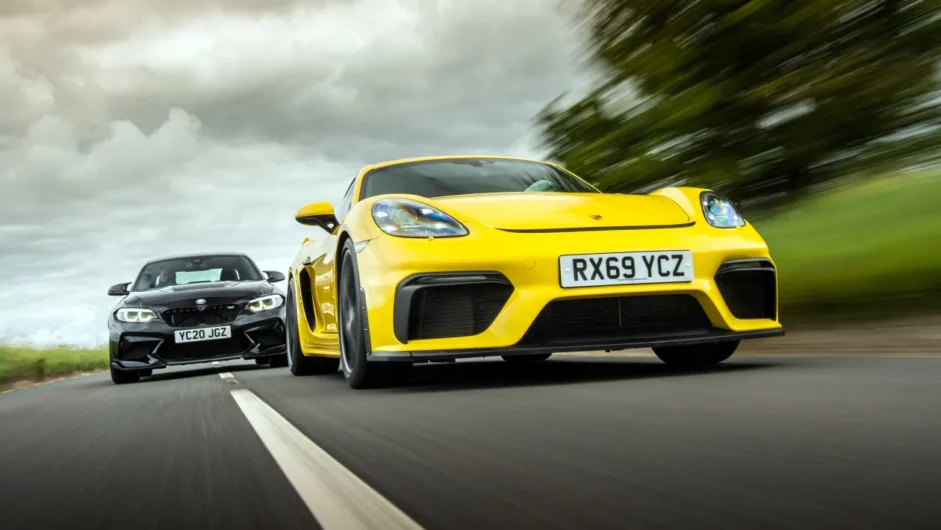
Back in the M2, unfreezing the picture, and it’s all profoundly different. The CS turns in and inspires genuine confidence – more than any other M-car I can think of bar an M4 GTS on a road exactly suited to its peculiarities. What you come to learn is that, somewhere beneath that squidgy wheel rim, the gentle tugging this way and that and the ebb and flow of resistance behind that slightly loose sensation around the straight-ahead is a pretty good indicator of the state of play down at the road’s surface. You’re not laser-beamed onto the apex like you are in the Porsche – you may even have to adjust your line on the way in – but the suspension tweaks on the CS give you more support, more directness. That you feel the roll and the movement of mass more is hardly surprising when you look at a picture of the two cars side by side – one low, purpose-built, the other tall, conventional and podgy.
The fun, though, is just beginning. In many ways I think how you feel about these two boils down to the respective weighting you put on each part of a corner. If ‘enthusiast driving’ to you is about carrying speed, precision, tactility and response, the GT4 has it sewn up, however much the BMW tries (and succeeds). But if you enjoy oversteer, the rear wheels overspeeding and the back of the car loose, needing to be controlled with your right foot but on your side, then suddenly the overall picture between them is nothing like as clear.
For all its swagger, sheer grunt and surprising weight, the M2 CS is a very friendly car over the limit. It enjoys going sideways, leaving black lines in the road from its relatively narrow 265-section rears, and generally being a lout. You can either drive it on the edge of grip, savouring that transition from neutrality to oversteer, or you can just keep your foot in…
Despite sharing exactly the same engine, that’s not something I’ve ever felt about an M3/M4. Even with the secretive 2018 model year tweaks and Competition upgrades that resulted in a car vastly improved over the spikey 2014 original, I would never dream of taking such liberties. Maybe it’s the size of that car, but I think there’s more to it than that. It’s not the weight, as the M3/M4 is only an extra 10-20kg heavier. Rather it’s that with the M2 CS you always feel on top of the situation, able to react and adjust when required. Even if there’s a sudden change in attitude it never feels like it’s trying to catch you out. In the wet though, well, there’ll be plenty of work to be done by the driver, that’s for sure.
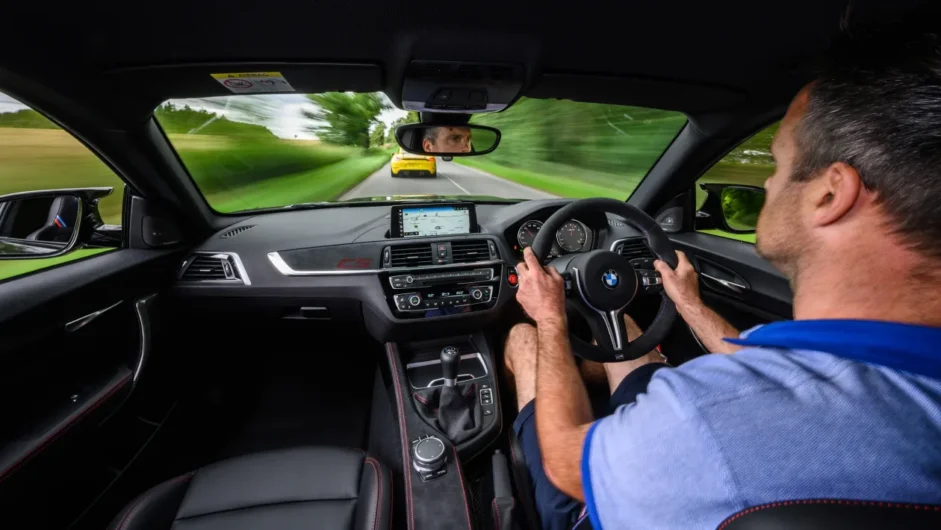
Of course, we know from experience that you can be just as expressive in a GT4 when on track. You can turn it in on the brakes and drift elegantly into the corner and it’ll smoke up its rear tyres in a slide, but the window between grip and slip is much smaller, and to really get it moving around requires deliberate manipulation of the physics involved. There’s no way I’d drive like that on the public road. The limits of the GT4, in the dry at least, are very, very high.
Talking of track work, our later venture out on Bedford Autodrome is stymied by weather, and the direct comparison and planned lap times we’d hoped to get isn’t possible on this occasion. We’ll try and remedy that situation very soon, but extrapolating their road characteristics onto a circuit would suggest that the GT4 is going to be very effective, while the M2 driver is going to have to manage traction very carefully, and may not have the same endurance underneath them as the Porsche driver. It should be a fascinating confrontation.
After a day’s comparison driving it’s time to ratchet it back a level or two. There’s nothing wrong with how the GT4 does this kind of commuting, but as I’m sure you can imagine, a GT department product isn’t meant to be the last word in comfort. I’d happily drive it as a daily, but being realistic, the sensory experience makes you well aware you’re in a car designed for fast road and serious track driving. The CS is different. The in-line six has a warming, comforting rumble when driven slowly, and with the adaptive damping set to Comfort the car is able to breathe with the road whilst still feeling controlled. Most of all, it’s hard to put into words just what a thrill it is to hook fourth at low speeds, and then let the engine do the work, sensing its note harden as it takes the strain, feeling that rippling torque in action. The CS seems to be able to add 65kph onto your speed like this almost instantly, as if the car’s in a vacuum and its weight no longer matters. Easy afternoons padding along in the CS, windows down and sun shining, are a lot of fun.
OK, let’s be clear, objectively the GT4 wins this test. It does so because pound for pound, it feels like the best driver’s car here. It’s an inspiring and pure package – one of the greats, a car you could keep a lifetime. I’d tick the Clubsport Package and bucket seat options but nothing else and hand over the subsequent $92,425 (up from $85,055 basic) without so much as a blink if I had that kind of money. If nothing else, how many more new driver’s cars will feature a freshly designed naturally aspirated engine? Not many, sadly.
But the M2 CS gets five stars too. Yes, it always felt indulgently expensive, and it’s no longer available to buy, but it’s rapid, highly capable in its own right and, more importantly, ridiculously good fun. Perhaps even more than that, for me personally it has a desirability that transcends the logic of money or so-called road testing. It’s been an awfully long time since I’ve been able to say something like that about an M-car, but I can’t really remember lusting after one in this way since driving a new E46 M3 CS manual. It’s that butterfly-trapped-in-stomach sensation you get when you spy the key on the side, or how it’s maddeningly impossible to not cast a backwards glance at it when you park up and walk away. Every… single… time. It’s just one of those cars – the sort that enrich our souls.
Specs
| Porsche 718 Cayman GT4 | BMW M2 CS | |
| Engine | Flat-six, 3995cc | In-line 6-cyl, 2979cc, twin-turbo |
| Power | 414bhp @ 7600rpm | 444bhp @ 6250rpm |
| Torque | 310lb ft @ 5000-6800rpm | 406lb ft @ 2350-5500rpm |
| Weight | 1420bhp | 1550kg |
| Power-to-weight | 296bhp/ton | 291bhp/ton |
| 0-100kph | 4.4sec | 4.2sec |
| Top speed | 302kph | 280kph (limited) |
| Basic price | $85,055 | $84,578 |
This article originally appeared at evo.co.uk
Copyright © evo UK, Autovia Publishing

